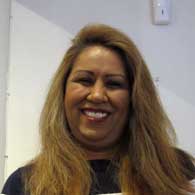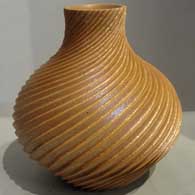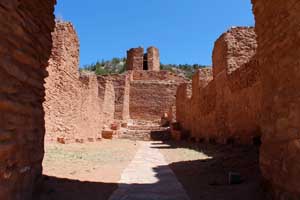
Dominique Toya
1971-2023
Jemez


Dominique Toya was born to Maxine Toya and Clarence Toya in 1971 at Jemez Pueblo. In those days she was known as Damian and she began creating pottery at about the age of five. She credited her mother, Maxine, with being the inspiration behind her interest in learning the traditional art. Her aunt, Laura Gachupin, and grandmother, Marie G. Romero, completed the roster of influential family potters in her early life.
Dominique said she was inspired to create her signature swirl melon pots by well-known Santa Clara potter Nancy Youngblood. She was aiming for nothing short of perfection, from the shape of her pots to the swirls that pour out of her openings. "The smaller the opening," she said, "the swirlier they get." The lines that circle a Dominique pot are perfectly spaced by taking an ice pick and scratching through the clay one line at a time, eventually covering the pot from top to bottom. "It's all done by eyeball," she said. "It's just a part of me." Later she would sandpaper the grooves deep into the pot. Those deep groves are another signature, as is the sparkle in the final micaceous slip. She signed her pots as: "Dominique Toya, Jemez", followed by the corn symbol to denote her clan origin.
Her career shifted into high gear with an award in the pottery division at the 2000 Annual Heard Museum Guild Indian Arts Fair & Market. Then she was awarded Best of Class for Pottery at the 2009 Santa Fe Indian Market. Then collaboration between Dominique and Jody Naranjo of Santa Clara Pueblo earned the duo the Best of Show award at the 2010 Eiteljorg Museum of the American Indian in Indianapolis. Career success, she believed, was rooted in her decision to become "Dominique" and to leave behind an outer self that didn't fit her. Born "Damian", Dominique was already a successful potter before she accepted herself as a woman. She underwent hormone therapy for several years as she completed her transformation. "My personal changes, my hormone therapy: everything happened all at once," she said.
Dominique told us she still got her inspiration from her mother, her grandmother and from good friends Nancy Youngblood and Jody Naranjo. Her favorite shape to work with was the water jar, preferably carved with deep swirls and slipped with micaceous clay. As a 5th generation Jemez Pueblo potter she said clay was her life and it allowed her to relax and enjoy an amazing and fulfilling journey through life.
In August 2023, Dominique was awarded the Raw Materials Award at the Santa Fe Indian Market. Sadly, she passed on in mid-December, 2023.
Some Awards Dominique Won
- 2024 Santa Fe Indian Market, Classification IIB, Category 607 - Boundary, First Place, shared with Maxine Toya and Sergio Youngblood Lugo
- 2023 Santa Fe Indian Market, Special Raw Material Award
- 2023 Santa Fe Indian Market, Classification IIA, Category 504 - Pins and Pendants, Second Place and an Honorable Mention
- 2019 Santa Fe Indian Market, Classification II - Pottery, Division A - Traditional unpainted pottery, Category 504 - Melon Bowls and Melon Jars, formed or carved: Honorable Mention
- 2019 Heard Museum Guild Indian Fair & Market, Classification II - Pottery, Division A - Painted, native clay, hand build, fired out-of-doors: First Place. Awarded for collaborative artwork with Maxine Toya. Awarded for artwork: Traditional Storage Jar
- 2019 Heard Museum Guild Indian Fair & Market, Classification II - Pottery, Division B - Unpainted, including ribbed, native clay, hand build, fired out-of-doors: Second Place. Awarded for artwork: Swirled Mica Water Jar
- 2019 Santa Fe Indian Market, Classification II - Pottery, Division B - Traditional Painted Pottery. Category 604 - Painted polychrome pottery in the style of Jemez, Zia, Santa Ana, Sandia, San Felipe, Isleta, any form: Second Place shared with Maxine Toya
- 2019 Santa Fe Indian Market, Classification II - Pottery, Division C - Traditional burnished black or red ware, incised, painted or carved, Category 704 - Incised or carved, any form: Second Place
- 2018 Santa Fe Indian Market, Classification II - Pottery, Division A - Traditional Unpainted Pottery, Category 504 - Melon Bowls and Melon Jars, Formed or Carved: Second Place
- 2018 Santa Fe Indian Market, Classification II - Pottery, Division B - Traditional Painted Pottery, Category 604 - Painted polychrome pottery in the style of Jemez, Zia, Santa Ana, Sandia, San Felipe, Isleta, any form: First Place. Shared First Place with Maxine Toya
- 2017 Santa Fe Indian Market: Classification II - Pottery, Division A - Traditional Unpainted Pottery, Category 504 - Melon bowls and melon jars, formed or carved: Honorable Mention
- 2016 Heard Museum Guild Indian Fair & Market, Classification II - Pottery, Division B - Traditional, Native Clay, Hand Built, Unpainted Including Ribbed: First Place
- 2015 Heard Museum Guild Indian Fair & Market. Judge's Choice Award - - Della C. Warrior. Awarded for artwork: Storage Jar
- 2015 Heard Museum Guild Indian Fair & Market. Judge's Choice Award - Kathleen L. Howard. Awarded for artwork: Storage Jar
- 2013 Heard Museum Guild Indian Fair & Market, Classification II - Pottery, Division B - Traditional, native clay, hand built, painted including ribbed: Honorable Mention
- 2012 Heard Museum Guild Indian Fair & Market, Classification II - Pottery, Division A - Traditional, native clay, hand built, painted: Honorable Mention shared with Maxine Toya
- 2012 Heard Museum Guild Indian Fair & Market, Classification II - Pottery, Division C - Traditional, native clay, hand built, carved: Honorable Mention
- 2010 Eiteljorg Museum Indian Market: Best of Show, collaborative work with Jody Naranjo. Awarded for artwork: "Double Insanity"
- 2010 Eiteljorg Museum Indian Market, Division 5 - Pottery, Category 501 - Traditional: First Place. Awarded for artwork: Swirled Vase
- 2010 Eiteljorg Museum Indian Market, Division 5 - Pottery, Category 502 - Contemporary: First Place for collaborative work with Jody Naranjo. Awarded for artwork: "Double Insanity"
- 2010 Eiteljorg Museum Indian Market, Division 5 - Pottery, Category 504 - Miscellaneous: First Place. Awarded for artwork: "Pride"
- 2010 Heard Museum Guild Indian Fair & Market, Classification II - Pottery, Division B - Traditional, native clay, hand built, unpainted, including ribbed: Second Place
- 2010 Heard Museum Guild Indian Fair & Market: Judge's Choice Award - Helen Kersting. Shared with Jody Naranjo. Awarded for artwork: "Double Insanity"
- 2008 Heard Museum Guild Indian Fair & Market. Classification II - Pottery: Best of Class
- 2008 Heard Museum Guild Indian Fair & Market. Classification II - Pottery, Division B - Traditional, native clay, hand built, unpainted: First Place
100 West San Francisco Street, Santa Fe, New Mexico 87501
(505) 986-1234 - www.andreafisherpottery.com - All Rights Reserved

Jemez Pueblo

Ruins of San Jose de las Jemez Mission
As the drought in the Four Corners region deepened in the late 1200s, several clans of Towa-speaking people migrated southeastward from the Four Corners area to the Canyon de San Diego area the southern Jemez mountains, in what is now north-central New Mexico. Other clans of Towa-speaking people migrated southwest and settled in the Jeddito Wash area, below Antelope Mesa and southeast of Hopi First Mesa, in what is now northeastern Arizona. The migrations began in earnest in the mid 1200s and were mostly complete by the mid 1300s.
Archaeologist Jesse Walter Fewkes argues that potsherds found in the vicinity of the ruin at Sikyátki (near the foot of Hopi First Mesa) speak to the strong influence of earlier Towa-speaking potters on what became "Sikyátki Polychrome" pottery (Sikyátki was a village at the foot of First Mesa, destroyed before the first Hopi contact with the Spanish in 1540). Fewkes maintained that Sikyátki Polychrome pottery was the finest ceramic ware ever made in prehistoric North America.
Francisco de Coronado and his men arrived in the Jemez Mountains of Nuevo Mexico in 1539. By then the Jemez people had built several large masonry villages among the canyons and on some high ridges in the area. Their population was estimated at about 30,000 and they were among the largest and most powerful tribes in northern New Mexico. Some of their pueblos reached five stories high and contained as many as 3,000 rooms.
Because of the nature of the landscape they inhabited, growing food was very hard. So the Jemez became traders, too, and their people traded goods all over the Southwest and northern Mexico.
The arrival of the Spanish was disastrous for the Jemez and they resisted the Spanish with all their might. That led to many atrocities against the tribe until they rose up in the Pueblo Revolt of 1680 and evicted the Spanish from northern New Mexico. With the Spanish gone, the Jemez destroyed much of what they had built on Jemez land. Then they concentrated on preparing themselves for the eventual return of the hated priests and the Spanish military.
The Spanish returned in 1692 and their efforts to retake northern New Mexico bogged down as the Jemez fought them doggedly for four years. In 1696 many Jemez came together, killed a Franciscan missionary and then fled to join their distant relatives in the Jeddito Wash area. They remained at Jeddito Wash for several years before returning to the Jemez Mountains. As a result of that long ago contact, there are still strong ties between the Jemez and their cousins on Navajo territory at Jeddito. On their return to the Jemez Mountains, the people built the pueblo they now live in (Walatowa: The Place) and made peace with the Spanish authorities.
Some of the Jemez people had been making a type of plainware pottery (simple, undecorated, utilitarian) when they were still in the Four Corners area, while others had developed a distinctive type of black-on-white pottery. In moving to the Jemez Mountains, they brought their knowledge and techniques with them but had to adapt to the different materials available to work with. Over time, the Jemez got better in their agricultural practices and began trading agricultural goods to the people of Zia Pueblo in return for pottery. By the mid-1700s, the Jemez people were producing almost no pottery.
East of what is now Santa Fe is where the ruins of Cicuyé (Pecos) Pueblo are found. Cicuyé was a large pueblo housing up to 2,000 people at its height. The people of Cicuyé, and some in the northern Galisteo Basin, were the only other speakers of the Towa language in New Mexico. When that area fell on increasingly hard times (Apache and Comanche raids, European diseases, drought), Cicuyé was finally abandoned in 1838 when the last 17 residents moved to Jemez. The Governor of Jemez welcomed them and allowed them to retain many of their Cicuyé tribal offices (governorship and all). Descendants of former Cicuyé families still return to the site of their ancestral home every year to perform religious ceremonies in honor of their ancestors.
When general American interest in Puebloan pottery started to take off in the 1960s, the people of Jemez sought to recover that lost heritage. Today, the practice of traditional pottery-making is very much alive and well among the Jemez.
The focus of Jemez pottery today has mostly turned to the making of storytellers, nativities and other figures. Figures are an art form that now accounts for more than three-quarters of their pottery production.
Storytellers are usually grandparent figures with the figures of children attached to their bodies. The grandparents are pictured singing tribal songs and oral histories to their descendants. While this visual representation was first created at Cochiti Pueblo (a site in close geographical proximity to Jemez Pueblo) in the early 1960s by Helen Cordero, it speaks to the relationship between grandparents and grandchildren of every culture. Nativities, corn maidens, singing angels and many different animal forms are also popular among the potters of Jemez.
The pottery vessels made at Jemez Pueblo today are generally not black-on-white. Instead, the potters have adopted many colors, styles and techniques from other pueblos to the point where Jemez potters no longer have one distinct style of their own beyond that which stems naturally from the materials they themselves acquire from their surroundings: it doesn't matter what the shape or design is, the clay itself says uniquely "Jemez."
100 West San Francisco Street, Santa Fe, New Mexico 87501
(505) 986-1234 - www.andreafisherpottery.com - All Rights Reserved
